TIME TRAVEL
/2 Comments/in Flowers, Fruit, Gardening, Vegetables/by Lee Reich18th Century, Here I Come!

Is that me playing the fife? No.
I just returned from time travel one month forward and a couple hundred years backward. Both at the same time! I did this with a trip to Colonial Williamsburg, Virginia, where black locust trees were in full bloom, which is about a month ahead of when they will be blooming up here in New York’s Hudson Valley.
The impetus for this time travel was Colonial Williamsburg’s Annual Garden Symposium, at which I was one of the presenters. (I did presentations on espalier fruit plants and on growing fruits in small gardens.)
Williamsburg is a magical place anytime of year, and especially so, for me, in spring. (I first fell in love with the place on a family trip when I was 7 years old; on subsequent visits, I’ve forgone the three-cornered hat I wore on that first trip.)
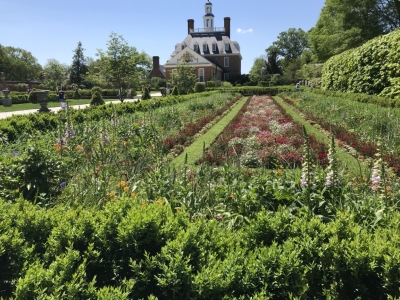
The governor’s garden
The Symposium included tours through many of the colonial gardens, where we could see, in action, “colonial” gardeners caring for their plants — in many cases using some of the same techniques we use today. Glass cloches, for instance, covered portions of some gardens to hasten warming of the soil for earlier sprouting of seeds. 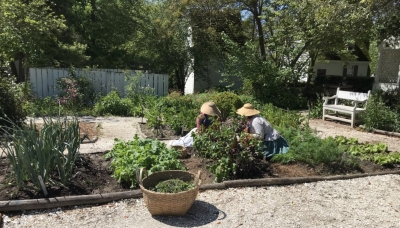 Flowering meads of herbs, flowers, and grasses blanketed the ground beneath most of the orchards, providing — probably unknown back in colonial days — forage for beneficial insects to help protect crop plants.
Flowering meads of herbs, flowers, and grasses blanketed the ground beneath most of the orchards, providing — probably unknown back in colonial days — forage for beneficial insects to help protect crop plants.
The flowers and vegetables — and fruits in the orchards — are the kinds and varieties grown in colonial times: cardoon, cornflower, chives, cockscomb, pot marigold, nasturtium, hollyhock, Johnny-jump-up, Tennis Ball lettuce, Yellow Crookneck squash, chard, and, of course, corn. Field corn, probably, but also, possibly, sweet corn, which was first given by the Iroquois to settlers in the late 18th century.
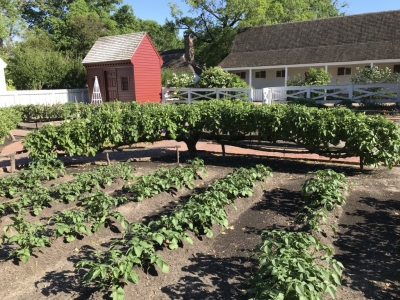
Espalier apple trees border vegetable plots
The gardens in Williamsburg provided and provide more than just sustenance. As in the orchards, flowers mingle with crop plants, in this case, vegetables. Most yards in the reconstructed town are one-half acre, with the land separated into sections with white wood fencing. The whole effect is très charmante. Couple that look with the lack of automobiles within the reconstructed town, and the quiet nights illuminated by the soft glow of fire and candle light (supplemented by electric lights with a candle-like glow), and I think I may want to move back into the 18th century.
Wall Envy
One problem I had with Colonial Williamsburg was wall envy. The church on Duke of Gloucester street, the governor’s mansion, and some other public spaces were enclosed by beautiful brick walls capped with functional and decorative rounded brick.
Most of the homes were covered with white-painted, wooden clapboards. The church and the governor’s mansion were made of brick, which, obviously, harmonized well with their brick walls.  My own home is brick; even a few four-foot-high walls around my vegetable garden and in other areas would improve the general appearance — and provide, warmer microclimates for cold-tender plants or early harvests. Not that the rustic locust fencing and arbors enclosing my vegetable garden look unsightly . . . but I’d like some brick walls.
My own home is brick; even a few four-foot-high walls around my vegetable garden and in other areas would improve the general appearance — and provide, warmer microclimates for cold-tender plants or early harvests. Not that the rustic locust fencing and arbors enclosing my vegetable garden look unsightly . . . but I’d like some brick walls.
Incidentally, bricks are made on site at one of the many trades demonstrated within the reconstructed town. I stopped in at the gun shop and stayed soaking up history I never learned in school — how most colonists owned relatively inaccurate muskets which were good enough for hunting and keeping varmints out of gardens, and the real sharpshooters were those with “long rifles,” that is, firearms with rifled barrels that spun their lead shot. But winning a battle wasn’t all about sharpshooters. Long rifles took much longer to reload than muskets, and which side threw the most lead in the air often was what decided who won.
(As part of my immersing myself in 18th century life, I signed up to go to a shooting range to actually fire a flintlock musket. This event, as recorded with 21st century technology, a phone, is documented Musket shooting1, Williamsburg, Musket shooting2, Williamsburg.)
Bricks, rifles, furniture: all these trades are practiced as they would have been in the 18th century. The rifle maker begins his work with nothing more than a block of wood and a block of iron. Four-hundred hours later, he has in hand a finished rifle. Fabric artisans begin with a sheep or flax seeds and some natural dyes. Cabinetmakers begin with trees or rough cut wood. Their tools are the same as those that to which their 18th century forebears had access.
Plant Envy
In addition to my wall envy, I also experienced the usual plant envy that afflicts me when I go south. Southern magnolia tree reach majestic proportions in Williamsburg; I would like to, but cannot, grow them in this cold climate. Crape myrtle is another, for its flowers and its bark mottled in pastel shades; too cold here for this one also.
I did come upon a number of specimens of fringe tree (Chionanthus spp.), with which I’m only vaguely familiar. The fringes of white blossoms dangling in profusion from the branches made me want to become more familiar, i.e. to plant, this shrubby tree. It turns out that I could — and will — grow fringe tree.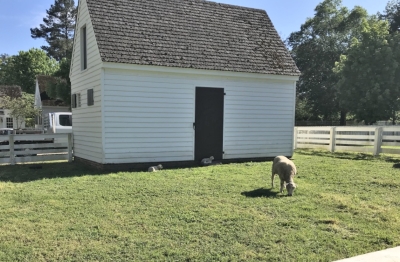
Fruit Tree Pruning
/14 Comments/in Fruit, Gardening, Pruning/by Lee ReichThe Why, and the Easiest
Following last week’s missive about pruning fruiting shrubs, I now move on to pruning my fruiting trees. Again, this is “dormant pruning.” Yes, even though the trees’ flower buds are about to burst or have already done so, their response will still, for a while longer, be that to dormant pruning.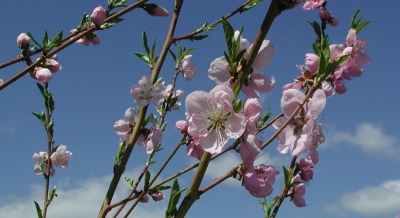 I mentioned flower buds, so these plants I’m pruning are mature, bearing plants. The objectives and, hence, pruning of a young tree are another ball game. As is renovative pruning, which is the pruning of long-neglected trees.
I mentioned flower buds, so these plants I’m pruning are mature, bearing plants. The objectives and, hence, pruning of a young tree are another ball game. As is renovative pruning, which is the pruning of long-neglected trees.
Most fruit trees need to be pruned (correctly) every year. Annual pruning keeps these trees healthy and keeps fruit within reach. This pruning also promotes year after year of good harvests (some fruit trees gravitate toward alternating years of feast and famine) and — most important — makes for the most luscious fruits.
With that said, as I’ve pointed out previously, a number of fruit trees can get by with little or no pruning, nothing more than thinning out congested branches, cutting back diseased branches to healthy wood, and removing root sprouts.
Among these easiest to prune fruit trees are persimmon, pawpaw, juneberry, jujube, quince, and medlar. (These are some of the uncommonly delectable fruits covered in my book Uncommon Fruits for Every Garden.) Trees such as juneberry and medlar are quite ornamental, so I also lop off or back wayward branches on these trees to keep them looking pretty.
Fruits Borne on New Shoots and/or 1-Year-Stems
The most straightforward approach to pruning those fruit trees that absolutely benefit from annual (correct) pruning is by grouping them according to their fruit-bearing habits.
Figs, for instance, are unique in being able to bear fruits on new, growing shoots.

Figlets on new growth
So the way to prune a fig tree — with caveats — is to lop back branches, which promotes new, fruit-bearing shoots. But not too, too far or the fruit will take too long to begin ripening. I prune branches of my potted or greenhouse Brown Turkey fig trees only as far back as their permanent trunks of a couple of feet or more in length.
Also, not necessarily all the stems should be pruned back on figs, because some varieties also — or only — bear fruit on one-year-old stems. My San Piero fig, for instance. I typically leave some one-year-old stems to bear an early crop, and drastically shorten others for the crop on new, growing shoots, which begins ripening later.
Peach and nectarine trees also bear on one-year-old stems, so are also pruned rather drastically. I shorten some branches to promote new shoot growth for next year’s harvest. I also remove some branches completely to prevent congestion, allowing branches to bask in sunlight, and breezes to dance among them. When finished, you should be able to throw a cat (figuratively) through the branches without touching them.
I shorten some branches to promote new shoot growth for next year’s harvest. I also remove some branches completely to prevent congestion, allowing branches to bask in sunlight, and breezes to dance among them. When finished, you should be able to throw a cat (figuratively) through the branches without touching them.
Fruits Borne on 1-Year + Older Stems
Fruit trees that bear their fruits on one-year-old as well as on older wood are the next grouping, and include plum, apricot, sweet, and tart cherry. The clusters of flower buds on branches of these trees are known as spurs. (Be careful not to put too much general meaning in “spur” because the word parades under a number of guises in the world of gardening.)
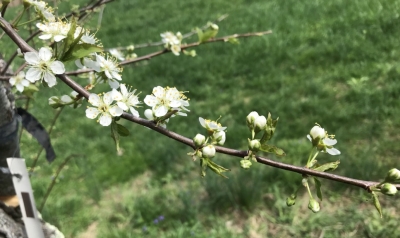
Clusters (spurs) of blossoms on plum
Pruning fruit trees removes some flower buds and potential fruits, which is all for the good because it lets the plant funnel more of its flavor-producing energy into fewer fruits so that those that remain are tastier and larger. Cherries, each of whose small fruits demand little energy, benefit the least of these fruits from such pruning so are the least pruned of the fruits in this category.
Apricot gets the most pruning in this group because its fruit spurs are borne on branches up to 3-years-old. That leaves plums, which get a moderate amount of pruning.
And Even Older Fruit-Bearing Stems
Apples and pears, the final grouping, are the most common tree fruits. Their individual branches each continue to bear flowers and fruits for many years.

Pear spur
Look at an older apple or pear branch and along it you see small, branching stems an inch or less long. These stem clusters are called — and I warned you — “spurs.”
Because their spurs live and bear for a decade or more, apple and pear trees require the least pruning of the fruit trees mentioned.
Then again, spurs do age, eventually becoming overcrowded and decrepit. So I thin out and shorten old spurs so that each has sufficient space and is periodically invigorated with stubby, new growth.

Thinning apple spurs
Exuberant, vertical shoots, known as watersprouts, often pop up on apple or pear branches. Mostly, they are unwanted because they’re not very fruitful and, left alone, will shade other parts of the tree. I cut these off right to their bases.
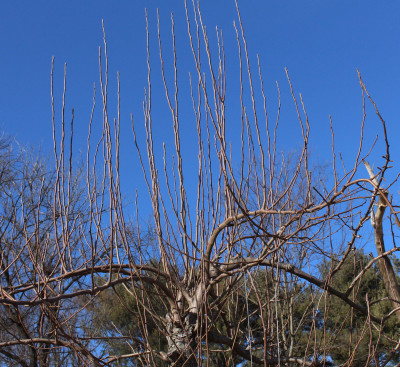
Pear watersprouts
Even better is to grab hold of watersprouts when you first notice them growing and rip them off with a quick downward pull. “When noticed,” in contrast to all the pruning I just wrote about, is not during the dormant season.
Pruning Gets Hectic
/9 Comments/in Fruit, Pruning/by Lee ReichEasiest to Prune Plants
Most of the pruning I do is “dormant pruning,” that is, pruning while plants are leafless. A few weeks ago, pruning was a relaxed affair with still-cold temperatures keeping the buds only slowly swelling in anticipation of upcoming growth. Then a few warm days kicked them into gear, making pruning more hectic.

Berries, later
Hecticness is little problem with those plants that are the easiest to prune because the work can be quick; other plants require my standing back with arms folded for some study before every few cuts.
Here on my farmden, easiest to prune plants include mature ornamental trees, shrubs, and vines, and even some fruits. Those fruits are American persimmon, pawpaw, and mulberry. They’re so easy because they can get by with little or no pruning.
Mostly what I do with the three fruit trees, every year or so, is to take a lopper or a saw and hack back . . . whoops, I mean “prune” . . . a tall limb back to a weaker growing, usually more horizontal, side branch. That’s to keep fruit within safe reach or not falling so far of its own accord that it splatters upon the ground. It also doesn’t leave a tree looking like a victim; done correctly and you hardly know that steel has been taken to the tree.
Easy, but Need Annual Pruning
Then there are easy-to-prune plants that do need annual pruning, but pruning them is as easy as following a recipe. Brambles — blackberries and raspberries — are counted in here. They all have perennial roots but their canes are biennial. That is, canes just grow the first year, then fruit and then die their second year.
The first step in pruning these plants, then, is to get down near ground level and cut all the two-year-old canes to the ground. These canes broadcast their age with peeling bark and an old and dead, or dying, appearance.
Gardeners telling tell me about their raspberry or blackberry patches make me cringe. “Patch” does conjure up an image of a cozy, cottage-y planting, but isn’t the way to grow these fruits if you want to make picking easy and limit disease problems. All of which leads to step two of this recipe.
Red or yellow raspberries spread to create a patch by sending up shoots via underground runners; black raspberries and blackberries do so by arching their long canes to the ground where they take root and make new plants. Too many new plants, in either case.
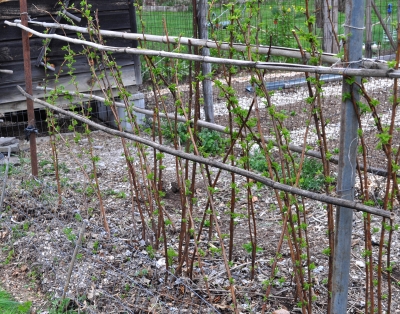
Red raspberry bed, pruned
So I limit my red or yellow raspberries to a swath only a foot wide, and then within that swath remove enough plants so those that remain are a few inches apart.
With black raspberries and blackberries, I remove any plants closer than 3 to 5 feet apart (depending on their vigor) and then thin out remaining canes in each remaining clump to the fattest and healthiest-looking half-dozen.
One more step for these berries is to shorten red or yellow canes enough to keep them from flopping around. How much depends on how tall they are and how they are trellised, if at all. Black raspberries and blackberries fruit on side shoots; these need to be shortened to about 18 inches long.
(So-called everbearing — aka “fallbearing” — red or yellow raspberries can be pruned as described above. Or, just lop the whole planting to the ground late each fall, sacrificing midsummer harvest but still offering late summer and early fall berries.)
Also Easy
Two more fruits also fall into this easy-to-prune category.
Lowbush blueberries, like brambles, bear on two-year-old (and, to a lesser extent, three-year-old stems). But they grow too many stems to selectively prune them.
So I take my hedge trimmer and every other year, or every third year, cut all stems to the ground.

Shearing lowbush blueberries
There’s no crop the year they are pruned but dividing a planting in halves or thirds and pruning a different half or third every year circumvents that drawback.
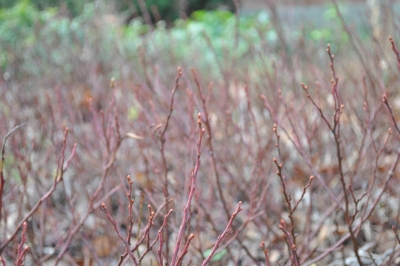
Lowbush blueberries, flower buds
Blackcurrants bear in a similar manner to lowbush blueberries but their stems are few enough for selective pruning. I cut to the ground any 3-year-old stems as well as anything more than the best half-dozen 1-year-old stems.
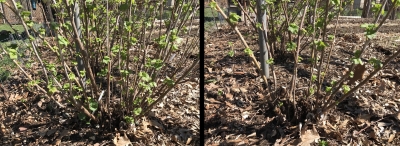
Blackcurrant, before & after pruning
Just a Wee Bit More Difficult
From here, I move on to shrubs — only slightly more difficult to prune — that bear fruit on older wood, which determines which stems I cut out.
Most gooseberries and redcurrants, for example, bear best on stems 2 and 3 years old. So the strategy here is the same as for brambles, except that the stems that I cut away are those that are 4-years-old. After that I remove excess new stems arising from ground level. When pruning is finished, the shrubs are left with about six each of one-, two-, and three-year-old stems.
Pruning blueberry bushes also follows the same strategy, except that since the bushes bear well on stems up to six-years-old, I prune away stems older than this and cut to the ground all except the healthiest 4 new stems.
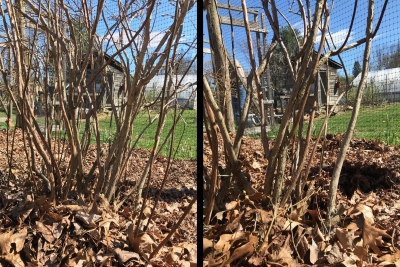
Blueberry before & after pruning
Now on to the fruit trees. Wait, I can’t do it now! I’ve got to run outside, grab my hand shears, lopper, and pocket saw, and do some pruning. Stay tuned next week for fruit tree pruning.
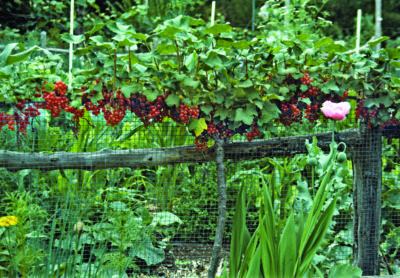
Redcurrant espalier. How to prune it? Some other time.
For more pruning detail, more plants, and more techniques, see my book The Pruning Book.

